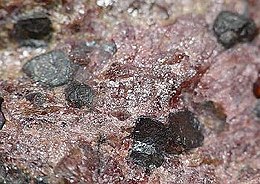| Sonolite | |
|---|---|
 Sonolite (in bottom left corner) with zincite and manganosite Sonolite (in bottom left corner) with zincite and manganosite | |
| General | |
| Category | Silicate minerals |
| Formula (repeating unit) | Mn9(SiO4)4(OH,F)2 |
| IMA symbol | Snl |
| Strunz classification | 9.AF.55 |
| Dana classification | 52.3.2d.3 |
| Crystal system | Monoclinic |
| Crystal class | Prismatic (2/m) (same H-M symbol) |
| Space group | P21/b |
| Unit cell | a = 4.87 Å, b = 10.66 Å c = 14.28 Å β = 100.3°, Z = 2 |
| Identification | |
| Color | Red-orange, pinkish brown to dark brown Colorless in thin section |
| Twinning | Common, singular or lamellar on {101} |
| Mohs scale hardness | 5.5 |
| Luster | Vitreous, dull |
| Diaphaneity | Transparent to translucent |
| Density | 3.82–4.00 (measured) |
| Optical properties | Biaxial (−) |
| Refractive index | nα = 1.765 nβ = 1.778 nγ = 1.787 |
| Birefringence | δ = 0.022 |
| 2V angle | 75° to 82° (measured) |
| Dispersion | r > v |
| References | |
Sonolite is a mineral with formula Mn9(SiO4)4(OH,F)2. The mineral was discovered in 1960 in the Sono mine in Kyoto Prefecture, Japan. In 1963, it was identified as a new mineral and named after the Sono mine.
Description
Sonolite is transparent to translucent and is red-orange, pinkish brown to dark brown in color and colorless in thin sections. The mineral has a granular habit or occurs as prismatic to anhedral crystals up to 2.5 cm (0.98 in). Sonolite is the manganese analogue of clinohumite, a dimorph of jerrygibbsite, and a member of the humite group.
The mineral occurs in metamorphosed manganese-rich deposits. Sonolite has been found in association with calcite, chlorite, franklinite, galaxite, manganosite, pyrochroite, rhodochrosite, tephroite, willemite, and zincite.
History
In 1960, Mayumi Yoshinaga was investigating alleghanyite and other manganese orthosilicates in Japan. He discovered a dull, red-brown mineral on the first level ore body of the Sono Mine, and later from a number of other sites. Using samples from ten locations in Japan and one in Taiwan, the mineral was described in 1963 and identified as a new mineral species. It was named sonolite after the mine in which it was first found and the name was approved by the International Mineralogical Association.
Distribution
As of 2012, sonolite has been found in Austria, France, Japan, Kyrgyzstan, Romania, Russia, Sweden, Switzerland, Taiwan, and the United States. The type material is held at Harvard University in Cambridge, Massachusetts, US.
References
- Warr, L.N. (2021). "IMA–CNMNC approved mineral symbols". Mineralogical Magazine. 85 (3): 291–320. Bibcode:2021MinM...85..291W. doi:10.1180/mgm.2021.43. S2CID 235729616.
- ^ "Sonolite" (PDF). Handbook of Mineralogy. Mineral Data Publishing. Retrieved June 20, 2012.
- ^ "Sonolite". Webmineral. Retrieved June 20, 2012.
- ^ "Sonolite". Mindat. Retrieved June 20, 2012.
- ^ Yoshinaga 1963, p. 1.
- Yoshinaga 1963, pp. 1–2.
Bibliography
- Yoshinaga, Mayumi (January 25, 1963). "Sonolite, a New Manganese Silicate Mineral" (PDF). Memoirs of the Faculty of Science, Kyushu University. 14 (1): 1–21. Retrieved June 20, 2012.
Further reading
- Cook, David (September–October 1969). "Sonolite, Alleghanyite and Leucophoenicite from New Jersey" (PDF). American Mineralogist. 54 (9 & 10): 1392–1398.
External links
![]() Media related to Sonolite at Wikimedia Commons
Media related to Sonolite at Wikimedia Commons